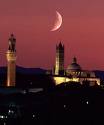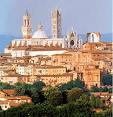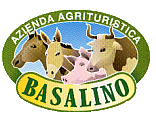|
 |
Siena
Self-contained and still part-rural
behind its medieval walls, Siena's great attraction is its
cityscape, a majestic Gothic ensemble that could be enjoyed
without venturing into a single museum. The physical and
spiritual heart of the city is the great scallop-shaped
piazza il Campo , loveliest of all Italian squares and scene
of the thrilling Palio bareback horse-race. Siena's Duomo
and Palazzo Pubblico are two of the purest examples of Italian
Gothic architecture, and the best of the city's paintings
- collected in the Museo Civico and Pinacoteca Nazionale
- are in the same tradition; the finest example of Sienese
Gothic is Duccio's Maestà , on show in the outstanding Museo
dell'Opera del Duomo . More frescoes fill the halls of Santa
Maria della Scala , the city's hospital for over 900 years
and now its premier exhibition space.
|
 |
For a hundred years or so, in
the twelfth and thirteenth centuries, Siena was one of the
major cities of Europe. Virtually the size of Paris, it controlled
most of southern Tuscany and its wool industry, dominated
the trade routes between France and Rome, and maintained Italy's
richest pre-Medici banks. This era reached an apotheosis with
the defeat of a much superior Florentine army at the battle
of Montaperti in 1260. Although the result was reversed permanently
nine years later, Siena embarked on an unrivalled urban development
under the guidance of its mercantile governors, the Council
of Nine . From 1287 to 1355 the city underwrote the completion
of its cathedral and then the Campo and its exuberant Palazzo
Pubblico . The prosperity came to an abrupt halt with the
Black Death , which reached Siena in May 1348; by October,
two-thirds of the 100,000 population had died. The city never
fully recovered (the population today is 60,000) and its politics,
always factional, descended into chaos. In 1557 Philip II
gave up Siena to Cosimo de' Medici in lieu of war services,
and the city subsequently became part of Cosimo's Grand Duchy
of Tuscany, and fell into decline. The lack of subsequent
development explains Siena's astonishing state of preservation:
little was built and still less demolished. Since World War
II, Siena has again become prosperous, due partly to tourism
and partly to the resurgence of the Monte dei Paschi di Siena
. This bank, founded in Siena in 1472 and currently the city's
largest employer, is one of the major players in Italian finance.
It today sponsors much of Siena's cultural life, co-existing,
apparently easily, with one of Italy's strongest left-wing
councils. |
|
The most popular trip from Siena
is northwest to the picturesque multi-towered village of San
Gimignano. Far fewer people take the trouble to sample the
ancient Etruscan town of Volterra , a highly rewarding stop
en route west from Siena to Pisa. |
 |
Everything is easily walkable
from the great central square of the Campo , which is built
at the intersection of a configuration of hills that looks,
on the map, like an upside-down Y. Each arm of the Y counts
as one of the city's terzi , or thirds, and each has its principal
thoroughfare, leading out from the Campo on elevated ridges:
humdrum Banchi di Sotto in the Terzo di San Martino on the
southeast; bustling, shop-lined Via di Città in the Terzo
di Città on the southwest; and elegant Banchi di Sopra in
the Terzo di Camollia on the north. The central core of alleys
- almost entirely medieval in plan and appearance, and closed
to traffic - can get a little disorientating, and it's surprisingly
easy to lose your fix on the Campo, masked as it is by high
buildings. The huge Duomo (and attendant museums, including
the unmissable Museo dell'Opera del Duomo and Santa Maria
della Scala ) sits on a hill above Via di Città, looking across
the deep Fontebranda valley north to the equally huge church
of San Domenico occupying its own hill; getting from one to
the other involves a lot of stairs, or a big semi-circular
detour |
| |
|
|
